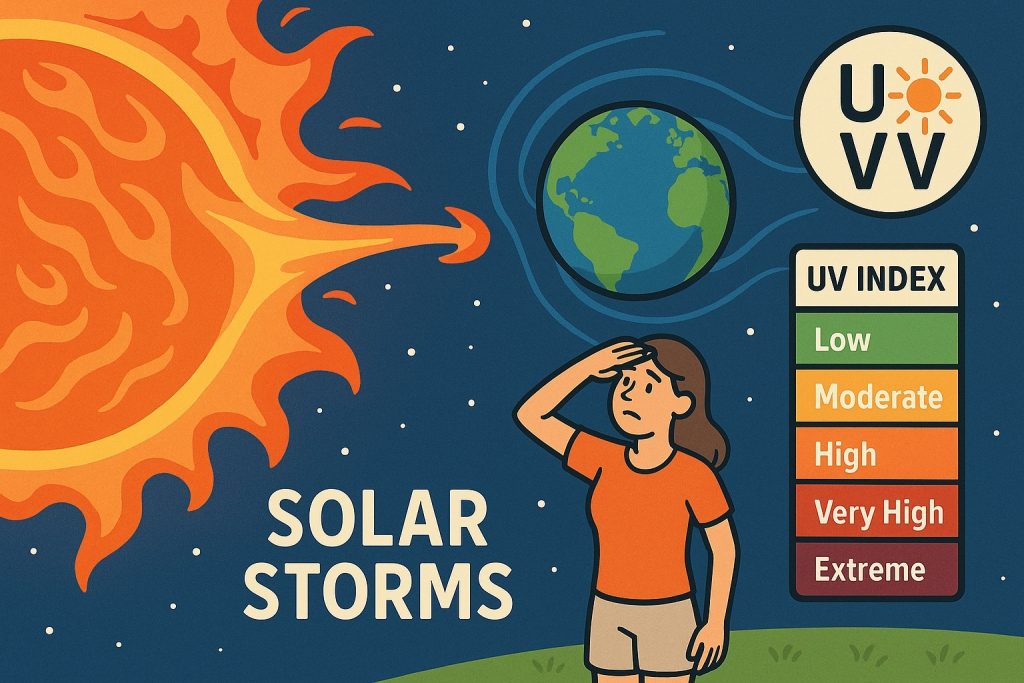The Sun is the engine of life on our planet, providing light, warmth, and energy. But it is also a source of powerful and sometimes dangerous phenomena—solar storms. These cosmic events can disrupt satellites, communications, and even power grids on Earth. Alongside these events, the Sun also affects our ultraviolet (UV) exposure, which is measured by the UV index—a key indicator of potential harm to human skin and eyes.
In this article, we’ll explore what solar storms are, how they impact our planet, and why understanding UV radiation is equally important for public health.
What Are Solar Storms?
Solar storms are disturbances in space caused by intense solar activity. They typically originate from:
- Solar flares – sudden bursts of radiation caused by magnetic energy release.
- Coronal Mass Ejections (CMEs) – massive clouds of charged particles ejected from the Sun’s corona.
- High-speed solar wind streams – fast-moving particles emitted from coronal holes.
When these solar events head toward Earth, they interact with our planet’s magnetosphere and atmosphere, causing what’s commonly called a geomagnetic storm.
Effects of Solar Storms on Earth
Solar storms can have both visible and invisible impacts:
1. Technology Disruption
- Damage or disablement of satellites
- GPS signal distortion
- Radio communication blackouts (especially near the poles)
- Power grid overloads and blackouts (like the 1989 Quebec blackout)
2. Auroras
- Solar particles collide with Earth’s magnetic field, creating auroras (northern and southern lights) visible closer to the equator during strong storms.
3. Radiation Hazards
- Increased radiation risk for astronauts and passengers in high-altitude flights
- Radiation exposure for airline crews, especially on polar routes
4. Effects on Animals
- Disruption of animal navigation systems that rely on Earth’s magnetic field, such as migratory birds, whales, and sea turtles
Solar Activity and Climate
Although solar storms don’t cause weather, long-term changes in solar activity can subtly influence Earth’s climate cycles. For example, periods of low sunspot activity (like the Maunder Minimum) have coincided with cooler global temperatures.
What Is the Ultraviolet Index?
While solar storms primarily involve charged particles, UV radiation is a different solar emission—electromagnetic energy in the ultraviolet part of the spectrum. The Ultraviolet Index (UVI) measures the strength of UV rays at Earth’s surface on a scale from 0 to 11+.
| UV Index | Risk Level | Recommendations |
|---|---|---|
| 0–2 | Low | Minimal protection needed |
| 3–5 | Moderate | Wear sunglasses, use SPF sunscreen |
| 6–7 | High | Reduce time in sun, wear hat & SPF |
| 8–10 | Very High | Extra protection needed |
| 11+ | Extreme | Avoid sun exposure if possible |
UV Index and Human Health
- Sunburn risk increases with UV intensity
- Skin cancer, especially melanoma, is strongly linked to UV overexposure
- Eye damage, such as cataracts and photokeratitis
- Immune suppression with prolonged exposure
UV radiation is highest:
- Around midday (10 AM – 4 PM)
- In tropical regions
- During summer months
- At high altitudes
- When reflective surfaces (snow, water, sand) are present
Glossary
- Coronal Mass Ejection (CME) – A massive burst of solar wind and magnetic fields rising above the solar corona.
- Magnetosphere – The region around Earth dominated by its magnetic field, which shields us from solar wind.
- Aurora – Colorful light displays in the sky caused by solar particles colliding with Earth’s atmosphere.
- Ultraviolet Radiation (UV) – Invisible rays from the Sun that can damage skin and eyes.
- UV Index (UVI) – A scale that measures the risk of harm from unprotected exposure to UV radiation.
Conclusion
The Sun is a dynamic, powerful star whose activity can both enrich and endanger life on Earth. From dazzling auroras to risky radiation spikes, solar storms remind us of our planet’s vulnerability in space. Meanwhile, understanding the UV index helps individuals protect themselves from daily solar exposure. As technology and climate challenges grow, so too must our awareness of the Sun’s complex relationship with our world.


